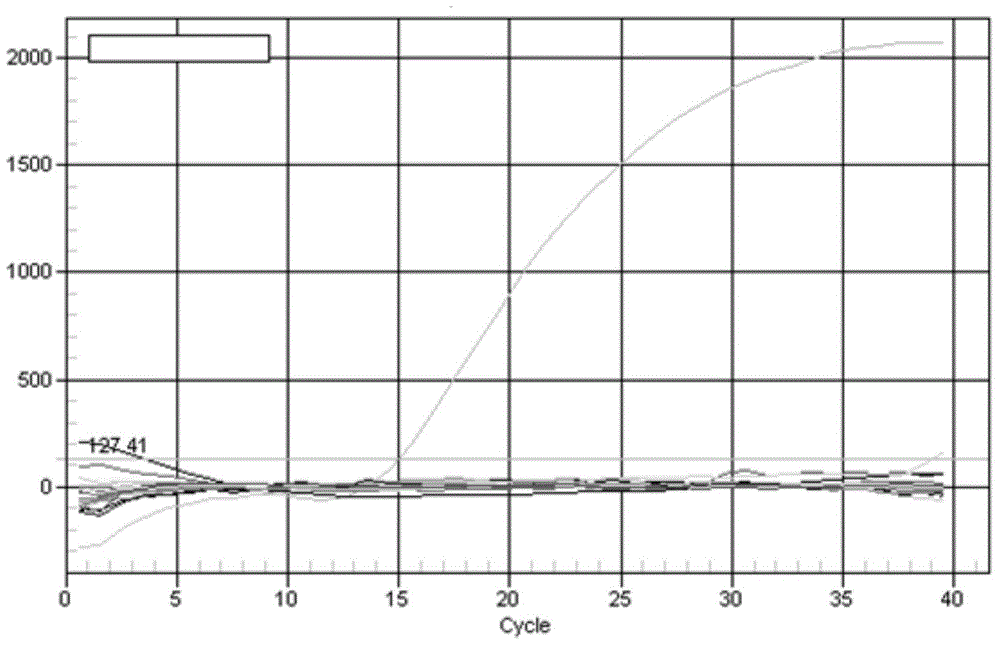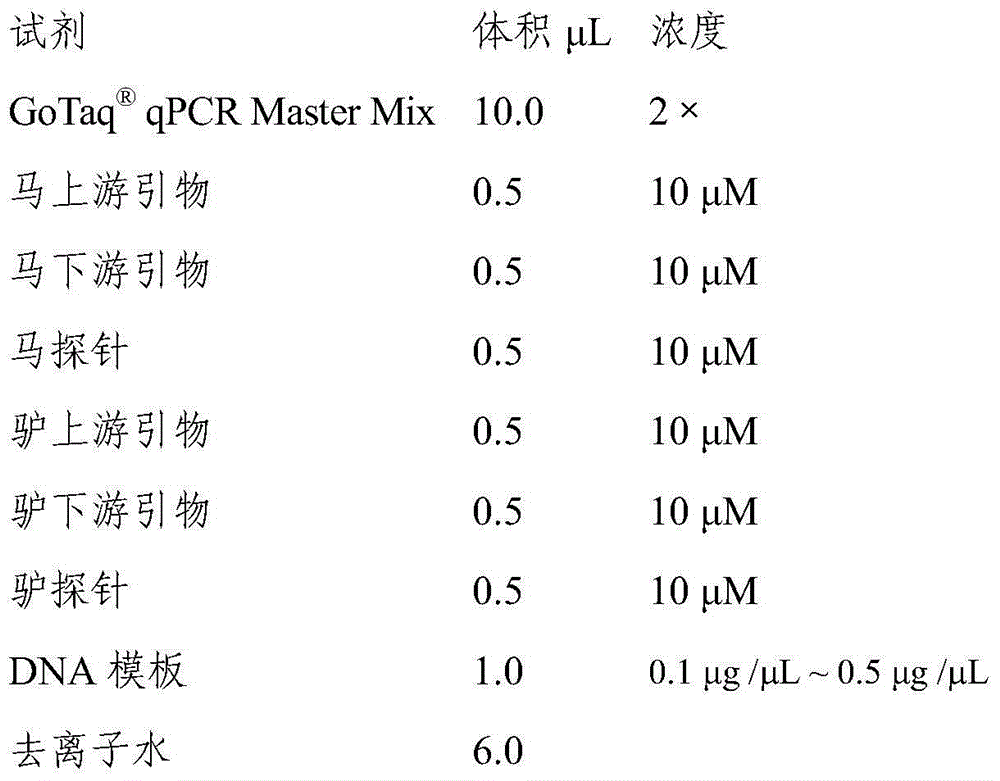Dual-fluorescence PCR method for simultaneously detecting original components of horse and donkey
A dual fluorescence, donkey-derived technology, applied in biochemical equipment and methods, recombinant DNA technology, microbial measurement/inspection, etc., can solve problems that have not been reported, achieve good sensitivity, increase protection, and resist adulteration fake effect
- Summary
- Abstract
- Description
- Claims
- Application Information
AI Technical Summary
Problems solved by technology
Method used
Image
Examples
Embodiment 1
[0027] The design of embodiment 1 primer
[0028] After a large number of comparisons of COX 1 genes in GenBank, the highly conserved and species-specific gene sequence of COX 1 was selected as a template, and the horse COX 1 / donkey COX 1-specific primer pair and Taqman MGB probe were designed, which were named horse COX 1 -F(P1), Horse COX 1-R(P2), Donkey COX 1-F(P3), Donkey COX 1-R(P4), Horse COX 1-FAM-MGB-Probe(Probe-P5), Donkey COX 1-VIC-MGB-Probe (Probe-P6), the primer and probe sequences for dual Taqman MGB real-time fluorescent PCR amplification are as follows:
[0029] P1: 5`-AACCCCCCCTATTCGTTTGATCT-3`
[0030] P2: 5`-ACGGTCTGTGAGAAGCATGGT-3`
[0031] P3: 5`-AGCCTCCTAATCCGTGCTGAA-3`
[0032] P4: 5`-ATGCATGGGCAGTTACAATAACA-3`
[0033] P5: 5`-FAM-AGCCCCCCGGTCC-MGB-3`
[0034] P6: 5`-VIC-ACCCTGCTGGGAGAT-MGB-3`
Embodiment 2
[0035] The establishment of embodiment 2 fluorescence quantitative PCR detection method
[0036] 1. Extract sample DNA
[0037] (1) Take 0.2g of horse meat or donkey meat samples and cut them into pieces as much as possible. Place in a 1.5ml centrifuge tube, add 1ml of cell lysis buffer, 20μl proteinase K (500μg / ml), and mix well. Water-bath in a constant temperature water bath at 65°C for 30 minutes, and shake the centrifuge tube several times intermittently. Centrifuge at 12,000 rpm for 5 minutes in a tabletop centrifuge, and transfer the supernatant to another centrifuge tube.
[0038] (2) Add an equal volume of phenol:chloroform mixture (1:1), shake and mix, and centrifuge at 12,000rpm for 10min.
[0039] (3) Take the supernatant to another tube, add an equal volume of chloroform, shake and mix, and centrifuge at 12,000 rpm for 10 min.
[0040] (4) Take the supernatant to another tube, add 1 / 10 volume of 3mol / L sodium acetate and 2 times the volume of absolute ethanol,...
Embodiment 3
[0055] Embodiment 3 specificity test
[0056] In order to verify the specificity of this kit, horse and donkey genomic DNA were used as positive controls, and pigs, cattle, sheep, goats, chickens, ducks, pigeons, quails, turkeys, ostriches, gray geese, cats, mice, domestic Dog, rabbit, roe deer, fox, mink, camel, deer, salmon, rainbow trout, perch, crucian carp, grass carp. A total of 25 species were detected, with dd H 2 O is a blank control, and the fluorescent quantitative PCR detection system established in Example 2 is used to detect the above-mentioned 26 species. After the amplification was completed, the same threshold was taken to analyze the data after deducting the background fluorescence signal, and the Ct value of each sample was determined. See the experimental results figure 1 , figure 2 .
[0057] After the amplification was completed, the same threshold was taken to analyze the data after deducting the background fluorescence signal, and the Ct value of ...
PUM
 Login to View More
Login to View More Abstract
Description
Claims
Application Information
 Login to View More
Login to View More - R&D
- Intellectual Property
- Life Sciences
- Materials
- Tech Scout
- Unparalleled Data Quality
- Higher Quality Content
- 60% Fewer Hallucinations
Browse by: Latest US Patents, China's latest patents, Technical Efficacy Thesaurus, Application Domain, Technology Topic, Popular Technical Reports.
© 2025 PatSnap. All rights reserved.Legal|Privacy policy|Modern Slavery Act Transparency Statement|Sitemap|About US| Contact US: help@patsnap.com



